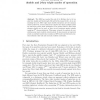12 search results - page 2 / 3 » ae 1999 |
SACRYPT
1999
Springer
13 years 9 months ago
1999
Springer
Abstract. DES and triple-DES are two well-known and popular encryption algorithms, but they both have the same drawback: their block size is limited to 64 bits. While the cryptogra...
EUROCRYPT
1999
Springer
13 years 9 months ago
1999
Springer
A recoding rule for exponentiation is a method for reducing the cost of the exponentiation ae by reducing the number of required multiplications. If w(e) is the (hamming) weight of...
ASIACRYPT
1999
Springer
13 years 9 months ago
1999
Springer
This paper presents a weakness in the key schedule of the AES candidate HPC (Hasty Pudding Cipher). It is shown that for the HPC version with a 128-bit key, 1 in 256 keys is weak i...
FSE
1999
Springer
13 years 9 months ago
1999
Springer
The DES has reached the end of its lifetime due to its too short key length and block length (56 and 64 bits respectively). As we are awaiting the new AES, triple (and double) encr...
ECOOPW
1999
Springer
13 years 9 months ago
1999
Springer
Although a considerable number of successful frameworks have been developed during the last decade, designing a high-quality framework is still a difficult task. Generally, it is ...


